Reduction of Signal Drift in a Wavelength Modulation Spectroscopy-Based Methane Flux Sensor
Abstract
:1. Introduction
2. Materials and Methods
2.1. Test Apparatus
2.2. Optical Measurement Noise and Drift
2.2.1. Quantification of Background WMS Signals
2.3. Thermal Enclosure and Component Testing Program
3. Results
3.1. Optical Component Testing
3.2. Detection Harmonic Selection
3.3. Improved Methane Flux Sensor
3.3.1. Updated Methane Sensor Design
4. Discussion
4.1. Temperature Stability of the Updated Sensor
4.2. Measurement Uncertainty of the Updated Sensor
4.3. Outlook
Author Contributions
Funding
Conflicts of Interest
References
- Joos, F.; Roth, R.; Fuglestvedt, J.S.; Peters, G.P.; Enting, I.G.; Von Bloh, W.; Brovkin, V.; Burke, E.J.; Eby, M.; Edwards, N.R.; et al. Carbon Dioxide and Climate Impulse Response Functions for the Computation of Greenhouse Gas Metrics: A Multi-Model Analysis. Atmos. Chem. Phys. 2013, 13, 2793–2825. [Google Scholar] [CrossRef]
- Forster, P.; Storelvmo, T.; Armour, K.; Collins, W.; Dufresne, J.-L.; Frame, D.; Lunt, D.J.; Mauritsen, T.; Palmer, M.D.; Watanabe, M.; et al. Chapter 7: The Earth’s Energy Budget, Climate Feedbacks, and Climate Sensitivity. In Climate Change 2021: The Physical Science Basis. Contribution of Working Group I to the Sixth Assessment Report of the Intergovernmental Panel on Climate Change; Masson-Delmotte, V., Zhai, P., Pirani, A., Connors, S.L., Péan, C., Berger, S., Caud, N., Chen, Y., Goldfarb, L., Gomis, M.I., et al., Eds.; Cambridge University Press: Cambridge, UK, 2021. [Google Scholar]
- Ocko, I.B.; Sun, T.; Shindell, D.; Oppenheimer, M.; Hristov, A.N.; Pacala, S.W.; Mauzerall, D.L.; Xu, Y.; Hamburg, S.P. Acting rapidly to deploy readily available methane mitigation measures by sector can immediately slow global warming. Environ. Res. Lett. 2021, 16, 054042. [Google Scholar] [CrossRef]
- IEA. Net Zero by 2050: A Roadmap for the Global Energy Sector; International Energy Agency (IEA): Paris, France, 2021. [Google Scholar]
- The White House Office of Domestic Climate Policy. U.S. Methane Emissions Reduction Action Plan; The White House: Washington, DC, USA, 2021. [Google Scholar]
- CCAC. Global Methane Pledge. Available online: https://www.globalmethanepledge.org/ (accessed on 28 April 2022).
- Hmiel, B.; Petrenko, V.V.; Dyonisius, M.N.; Buizert, C.; Smith, A.M.; Place, P.F.; Harth, C.; Beaudette, R.; Hua, Q.; Yang, B.; et al. Preindustrial 14CH4 Indicates Greater Anthropogenic Fossil CH4 Emissions. Nature 2020, 578, 409–412. [Google Scholar] [CrossRef] [PubMed]
- Alvarez, R.A.; Zavala-Araiza, D.; Lyon, D.R.; Allen, D.T.; Barkley, Z.R.; Brandt, A.R.; Davis, K.J.; Herndon, S.C.; Jacob, D.J.; Karion, A.; et al. Assessment of Methane Emissions from the U.S. Oil and Gas Supply Chain. Science 2018, 361, 186–188. [Google Scholar] [CrossRef] [PubMed]
- Chen, Y.; Sherwin, E.D.; Berman, E.S.F.; Jones, B.B.; Gordon, M.P.; Wetherley, E.B.; Kort, E.A.; Brandt, A.R. Quantifying Regional Methane Emissions in the New Mexico Permian Basin with a Comprehensive Aerial Survey. Environ. Sci. Technol. 2022, 56, 4317–4323. [Google Scholar] [CrossRef]
- Tyner, D.R.; Johnson, M.R. Where the Methane Is—Insights from Novel Airborne LiDAR Measurements Combined with Ground Survey Data. Environ. Sci. Technol. 2021, 55, 9773–9783. [Google Scholar] [CrossRef]
- Johnson, M.R.; Tyner, D.R.; Conley, S.A.; Schwietzke, S.; Zavala-Araiza, D. Comparisons of Airborne Measurements and Inventory Estimates of Methane Emissions in the Alberta Upstream Oil and Gas Sector. Environ. Sci. Technol. 2017, 51, 13008–13017. [Google Scholar] [CrossRef]
- Thompson, R.L.; Sasakawa, M.; Machida, T.; Aalto, T.; Worthy, D.; Lavric, J.V.; Myhre, C.L.; Stohl, A. Methane Fluxes in the High Northern Latitudes for 2005-2013 Estimated Using a Bayesian Atmospheric Inversion. Atmos. Chem. Phys. 2017, 17, 3553–3572. [Google Scholar] [CrossRef]
- Chan, E.; Worthy, D.E.J.; Chan, D.; Ishizawa, M.; Moran, M.D.; Delcloo, A.; Vogel, F. Eight-Year Estimates of Methane Emissions from Oil and Gas Operations in Western Canada Are Nearly Twice Those Reported in Inventories. Environ. Sci. Technol. 2020, 54, 14899–14909. [Google Scholar] [CrossRef]
- Roscioli, J.R.; Herndon, S.C.; Yacovitch, T.I.; Knighton, W.B.; Zavala-Araiza, D.; Johnson, M.R.; Tyner, D.R. Characterization of Methane Emissions from Five Cold Heavy Oil Production with Sands (CHOPS) Facilities. J. Air Waste Manag. Assoc. 2018, 68, 671–684. [Google Scholar] [CrossRef]
- Lavoie, T.N.; Shepson, P.B.; Cambaliza, M.O.L.; Stirm, B.H.; Conley, S.A.; Mehrotra, S.; Faloona, I.C.; Lyon, D.R. Spatiotemporal Variability of Methane Emissions at Oil and Natural Gas Operations in the Eagle Ford Basin. Environ. Sci. Technol. 2017, 51, 8001–8009. [Google Scholar] [CrossRef] [PubMed]
- Lyon, D.R.; Alvarez, R.A.; Zavala-Araiza, D.; Brandt, A.R.; Jackson, R.B.; Hamburg, S.P. Aerial Surveys of Elevated Hydrocarbon Emissions from Oil and Gas Production Sites. Environ. Sci. Technol. 2016, 50, 4877–4886. [Google Scholar] [CrossRef] [PubMed]
- Festa-Bianchet, S.A.; Seymour, S.P.; Tyner, D.R.; Johnson, M.R. A Wavelength Modulation Spectroscopy-Based Methane Flux Sensor for Quantification of Venting Sources at Oil and Gas Sites. Sensors 2022, 22, 4175. [Google Scholar] [CrossRef] [PubMed]
- Shemshad, J.; Aminossadati, S.M.; Kizil, M.S. A Review of Developments in near Infrared Methane Detection Based on Tunable Diode Laser. Sens. Actuators B Chem. 2012, 171–172, 77–92. [Google Scholar] [CrossRef]
- Norooz Oliaee, J.; Sabourin, N.A.; Festa-Bianchet, S.A.; Gupta, J.A.; Johnson, M.R.; Thomson, K.A.; Smallwood, G.J.; Lobo, P. Development of a Sub-Ppb Resolution Methane Sensor Using a GaSb-Based DFB Diode Laser near 3270 Nm for Fugitive Emission Measurement. ACS Sens. 2022, 7, 564–572. [Google Scholar] [CrossRef]
- Schoonbaert, S.B.; Tyner, D.R.; Johnson, M.R. Remote Ambient Methane Monitoring Using Fiber-Optically Coupled Optical Sensors. Appl. Phys. B 2015, 119, 133–142. [Google Scholar] [CrossRef]
- Measures, R.M. Selective Excitation Spectroscopy and Some Possible Applications. J. Appl. Phys. 1968, 39, 5232. [Google Scholar] [CrossRef]
- Philippe, L.C.; Hanson, R.K. Laser-Absorption Mass Flux Sensor for High-Speed Airflows. Opt. Lett. 1991, 16, 2002–2004. [Google Scholar] [CrossRef]
- Kurtz, J.; Wittig, S.; O’Byrne, S. Applicability of a Counterpropagating Laser Airspeed Sensor to Aircraft Flight Regimes. J. Aircr. 2016, 53, 439–450. [Google Scholar] [CrossRef]
- Arroyo, M.P.; Langlois, S.; Hanson, R.K. Diode-Laser Absorption Technique for Simultaneous Measurements of Multiple Gasdynamic Parameters in High-Speed Flows Containing Water Vapor. Appl. Opt. 1994, 33, 3296–3307. [Google Scholar] [CrossRef]
- Upschulte, B.; Miller, M.; Allen, M.G.; Jackson, K.; Gruber, M.; Mathur, T. Continuous Water Vapor Mass Flux and Temperature Measurements in a Model Scramjet Combustor Using a Diode Laser Sensor. In Proceedings of the 37th AIAA Aerospace Sciences Meeting & Exhibit, Reno, NV, USA, 11–14 January 1999; American Institute of Aeronautics and Astronautics: Reston, VI, USA, 1999. [Google Scholar]
- Schultz, I.A.; Goldenstein, C.S.; Jeffries, J.B.; Hanson, R.K.; Rockwell, R.D.; Goyne, C.P. Spatially Resolved Water Measurements in a Scramjet Combustor Using Diode Laser Absorption. J. Propuls. Power 2014, 30, 1551–1558. [Google Scholar] [CrossRef]
- Strand, C.L.; Hanson, R.K. Quantification of Supersonic Impulse Flow Conditions via High-Bandwidth Wavelength Modulation Absorption Spectroscopy. AIAA J. 2015, 53, 2978–2987. [Google Scholar] [CrossRef]
- Chen, S.J.; Paige, M.E.; Silver, J.A.; Williams, S.; Barhorst, T. Laser-Based Mass Flow Rate Sensor Onboard HIFiRE Flight 1. In Proceedings of the 45th AIAA/ASME/SAE/ASEE Joint Propulsion Conference & Exhibit, Denver, CO, USA, 2–5 August 2009; pp. 1–7. [Google Scholar] [CrossRef]
- Barhorst, T.; Williams, S.; Chen, S.J.; Paige, M.E.; Silver, J.A.; Sappey, A.; McCormick, P.; Masterson, P.; Zhao, Q.; Sutherland, L.; et al. Development of an in Flight Non-Intrusive Mass Capture System. In Proceedings of the 45th AIAA/ASME/SAE/ASEE Joint Propulsion Conference & Exhibit, Denver, CO, USA, 2–5 August 2009; pp. 1–11. [Google Scholar] [CrossRef]
- Lyle, K.H.; Jeffries, J.B.; Hanson, R.K. Diode-Laser Sensor for Air-Mass Flux 1: Design and Wind Tunnel Validation. AIAA J. 2007, 45, 2204–2212. [Google Scholar] [CrossRef]
- Chang, L.S.; Jeffries, J.B.; Hanson, R.K. Mass Flux Sensing via Tunable Diode Laser Absorption of Water Vapor. AIAA J. 2010, 48, 2687–2693. [Google Scholar] [CrossRef]
- National Fire Protection Association (NFPA). National Electrical Code (NEC); NFPA: Quincy, MA, USA, 2017; ISBN 9781455912773. [Google Scholar]
- CSA Group. Canadian Electrical Code, Part I; CSA Group: Toronto, ON, Canada, 2015. [Google Scholar]
- Werle, P.; Mucke, R.; Slemr, F. The Limits of Signal Averaging in Atmospheric Trace-Gas Monitoring by Tunable Diode-Laser Absorption Spectroscopy (TDLAS). Appl. Phys. B 1993, 57, 131–139. [Google Scholar] [CrossRef]
- Kluczynski, P.; Axner, O. Theoretical Description Based on Fourier Analysis of Wavelength-Modulation Spectrometry in Terms of Analytical and Background Signals. Appl. Opt. 1999, 38, 5803. [Google Scholar] [CrossRef]
- Kluczynski, P.; Gustafsson, J.; Lindberg, M.; Axner, O. Wavelength Modulation Absorption Spectrometry—an Extensive Scrutiny of the Generation of Signals. At. Spectrosc. 2001, 56, 1277–1354. [Google Scholar] [CrossRef]
- Woodward, J.T.; Shaw, P.-S.; Yoon, H.W.; Zong, Y.; Brown, S.W.; Lykke, K.R. Invited Article: Advances in tunable laser-based radiometric calibration applications at the National Institute of Standards and Technology, USA. Rev. Sci. Instrum. 2018, 89, 091301. [Google Scholar] [CrossRef]
- Rieker, G.B.; Jeffries, J.B.; Hanson, R.K. Calibration-Free Wavelength-Modulation Spectroscopy for Measurements of Gas Temperature and Concentration in Harsh Environments. Appl. Opt. 2009, 48, 5546–5560. [Google Scholar] [CrossRef]
- Linnerud, I.; Kaspersen, P.; Jaeger, T. Gas Monitoring in the Process Industry Using Diode Laser Spectroscopy. Appl. Phys. B Lasers Opt 1998, 67, 297–305. [Google Scholar] [CrossRef]
- Masiyano, D.; Hodgkinson, J.; Schilt, S.; Tatam, R.P. Self-Mixing Interference Effects in Tunable Diode Laser Absorption Spectroscopy. Appl. Phys. B Lasers Opt. 2009, 96, 863–874. [Google Scholar] [CrossRef]
- Rickenbach, R.; Wendland, P. Germanium Photodiodes—Temperature And Uniformity Effects. SPIE 1985, 0559, 198. [Google Scholar] [CrossRef]
- Sibley, A.; Gamouras, A.; Todd, A.D.W. Uniformity measurements of large-area indium gallium arsenide and germanium photodetectors. J. Phys. Conf. Ser. 2018, 1065, 082010. [Google Scholar] [CrossRef]
- Tu, G.; Dong, F.; Wang, Y.; Culshaw, B.; Zhang, Z.; Pang, T.; Xia, H.; Wu, B. Analysis of Random Noise and Long-Term Drift for Tunable Diode Laser Absorption Spectroscopy System at Atmospheric Pressure. IEEE Sens. J. 2015, 15, 3535–3542. [Google Scholar] [CrossRef]
- Werle, P. Tunable Diode Laser Absorption Spectroscopy: Recent Findings and Novel Approaches. Infrared Phys. Technol. 1996, 37, 59–66. [Google Scholar] [CrossRef]
- Sun, H.C.; Whittaker, E.A. Novel Etalon Fringe Rejection Technique for Laser Absorption Spectroscopy. Appl. Opt. 1992, 31, 4998–5002. [Google Scholar] [CrossRef]
- Yoon, H.W.; Butler, J.J.; Larason, T.C.; Eppeldauer, G.P. Linearity of InGaAs Photodiodes. Metrologia 2003, 40, 1–5. [Google Scholar] [CrossRef]
- Quimbly, R.S. Photonics and Lasers: An Introduction, 1st ed.; John Wiley & Sons: Hoboken, NJ, USA, 2006. [Google Scholar]
- Yoon, H.W.; Dopkiss, M.C.; Eppeldauer, G.P. Performance Comparisons of InGaAs, Extended InGaAs, and Short-Wave HgCdTe Detectors between 1 Mm and 2.5 Mm. Infrared Spaceborne Remote Sens. XIV 2006, 6297, 629703. [Google Scholar] [CrossRef]
- D’Hondt, M.D.; Moerman, I.; Demeester, P. Dark Current Optimisation of 2.5 Um Wavelength, 2% Mismatched InGaAs Photodetectors on InP. In Proceedings of the 1998 International Conference on Indium Phosphide and Related Materials, Ibaraki, Japan, 11–15 May 1998; pp. 55–58. [Google Scholar] [CrossRef]
- D’Hondt, M.D.; Moerman, I.; Demeester, P. Dark Current Optimisation for MOVPE Grown 2.5 μm Wavelength InGaAs Photodetectors. Electron. Lett. 1998, 34, 910–912. [Google Scholar] [CrossRef]
- John, J.; Zimmermann, L.; Nemeth, S.; Colin, T.; Merken, P.; Borghs, S.; Van Hoof, C.A. Extended InGaAs on GaAs Detectors for SWIR Linear Sensors. Infrared Technol. Appl. XXVII 2001, 4369, 692–697. [Google Scholar] [CrossRef]
- Schaefer, A.R.; Zalewski, E.F.; Geist, J. Silicon Detector Nonlinearity and Related Effects. Appl. Opt. 1983, 22, 1232. [Google Scholar] [CrossRef] [PubMed]
- Bartula, R.J.; Sanders, S.T. Estimation of Signal Noise Induced by Multimode Optical Fibers. Opt. Eng. 2008, 47, 035002. [Google Scholar] [CrossRef]
- Thorlabs Inc. Polaris® Side Optic Retention Mounts for Ø1/2″ Optics. Available online: https://www.thorlabs.com/newgrouppage9.cfm?objectgroup_id=10690 (accessed on 11 October 2021).
- Cassidy, D.T.; Reid, J. Atmospheric Pressure Monitoring of Trace Gases Using Tunable Diode Lasers. Appl. Opt. 1982, 21, 1185–1190. [Google Scholar] [CrossRef] [PubMed]
- Hanson, R.K.; Jeffries, J.B.; Sun, K.; Sur, R.; Chao, X. Method for Calibration-Free Scanned-Wavelength Modulation Spectroscopy for Gas Sensing. Worldwide Applications WO2013096396A1, 27 June 2013. [Google Scholar]
- Sun, K.; Chao, X.; Sur, R.; Goldenstein, C.S.; Jeffries, J.B.; Hanson, R.K. Analysis of Calibration-Free Wavelength-Scanned Wavelength Modulation Spectroscopy for Practical Gas Sensing Using Tunable Diode Lasers. Meas. Sci. Technol. 2013, 24, 125203. [Google Scholar] [CrossRef]
- Chang, L.S. Development of a Diode Laser Sensor for Measurement of Mass Flux in Supersonic Flow. Ph.D. Thesis, Standford University, Stanford, CA, USA, 2011. [Google Scholar]
- Chang, L.S.; Strand, C.; Jeffries, J.B.; Hanson, R.K.; Diskin, G.; Gaffney, R.; Capriotti, D. Supersonic Mass Flux Measurements via Tunable Diode Laser Absorption and Non-Uniform Flow Modeling. AIAA J. 2011, 49, 2783–2791. [Google Scholar] [CrossRef]
- Rothman, L.S.; Gordon, I.E.; Babikov, Y.; Barbe, A.; Chris Benner, D.; Bernath, P.F.; Birk, M.; Bizzocchi, L.; Boudon, V.; Brown, L.R.; et al. The HITRAN2012 Molecular Spectroscopic Database. J. Quant. Spectrosc. Radiat. Transf. 2013, 130, 4–50. [Google Scholar] [CrossRef]
- SK MER. Directive PNG036: Venting and Flaring Requirements; Saskatchewan Ministry of Energy and Resources (SK MER): Regina, SK, Canada, 2020. [Google Scholar]
- AER. Manual 015: Estimating Methane Emissions; Alberta Energy Regulator (AER): Calgary, AB, Canada, 2018. [Google Scholar]
- US EPA. AP 42, 5th Ed., Volume I Chapter 7: Liquid Storage Tanks; United Stated Environmental Protection Agency (US EPA): Research Triangle Park, NC, USA, 2006.
- Tyner, D.R.; Johnson, M.R. Improving Upstream Oil and Gas Emissions Estimates with Updated Gas Composition Data; Carleton University Energy & Emissions Research Lab.: Ottawa, ON, USA, 2020. [Google Scholar]
- ECCC. 2019 National Inventory Report (NIR)—Part 2; Environment and Climate Change Canada (ECCC): Ottawa, ON, Canada, 2021. [Google Scholar]
- Peachey, B. Conventional Heavy Oil Vent Quantification Standards; New Paradigm Engineering Ltd.: Edmonton, AB, Canada, 2004. [Google Scholar]
- Peachey, B. Gas-Oil-Ratio/Gas-In-Solution Project; New Paradigm Engineering Ltd.: Edmonton, AB, Canada, 2019. [Google Scholar]
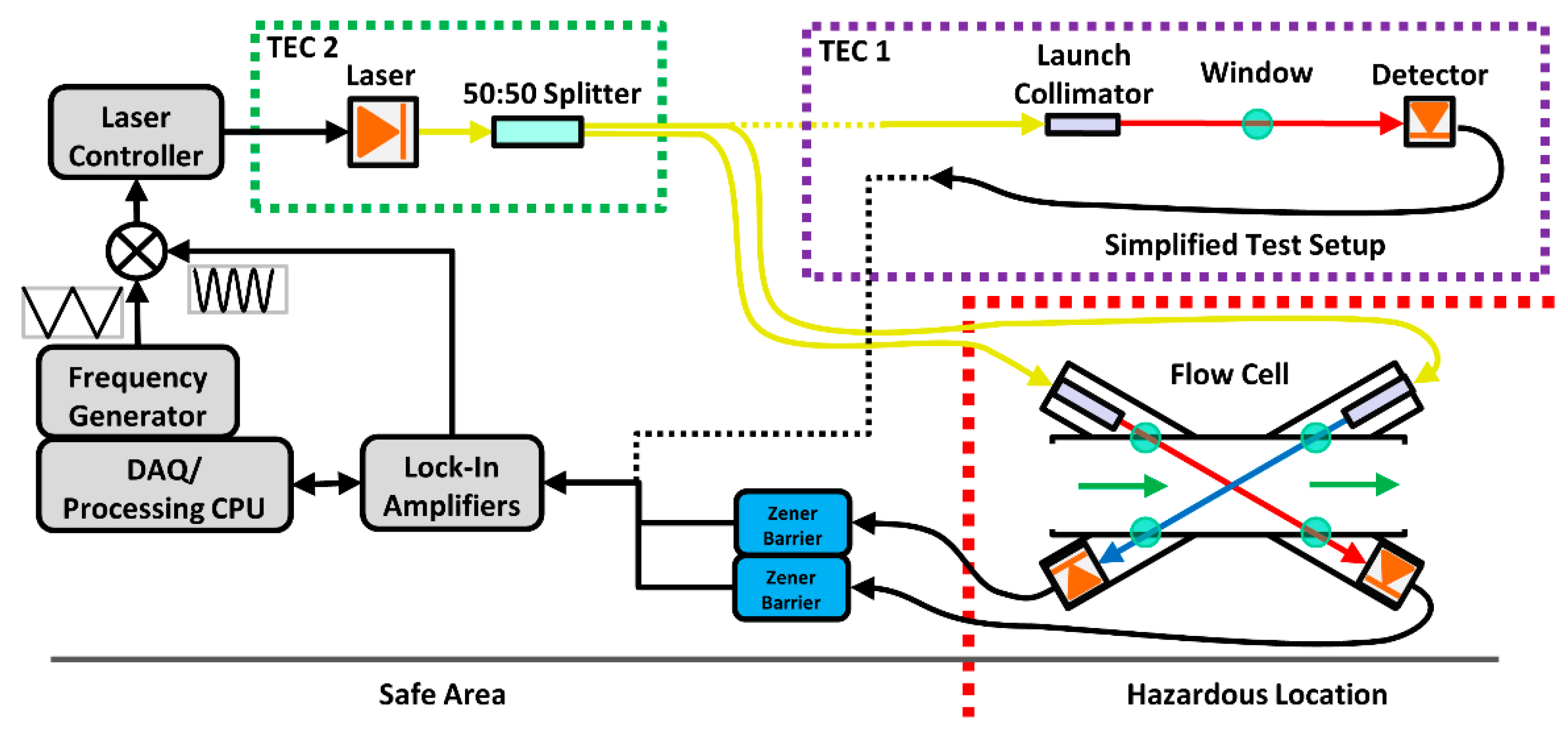
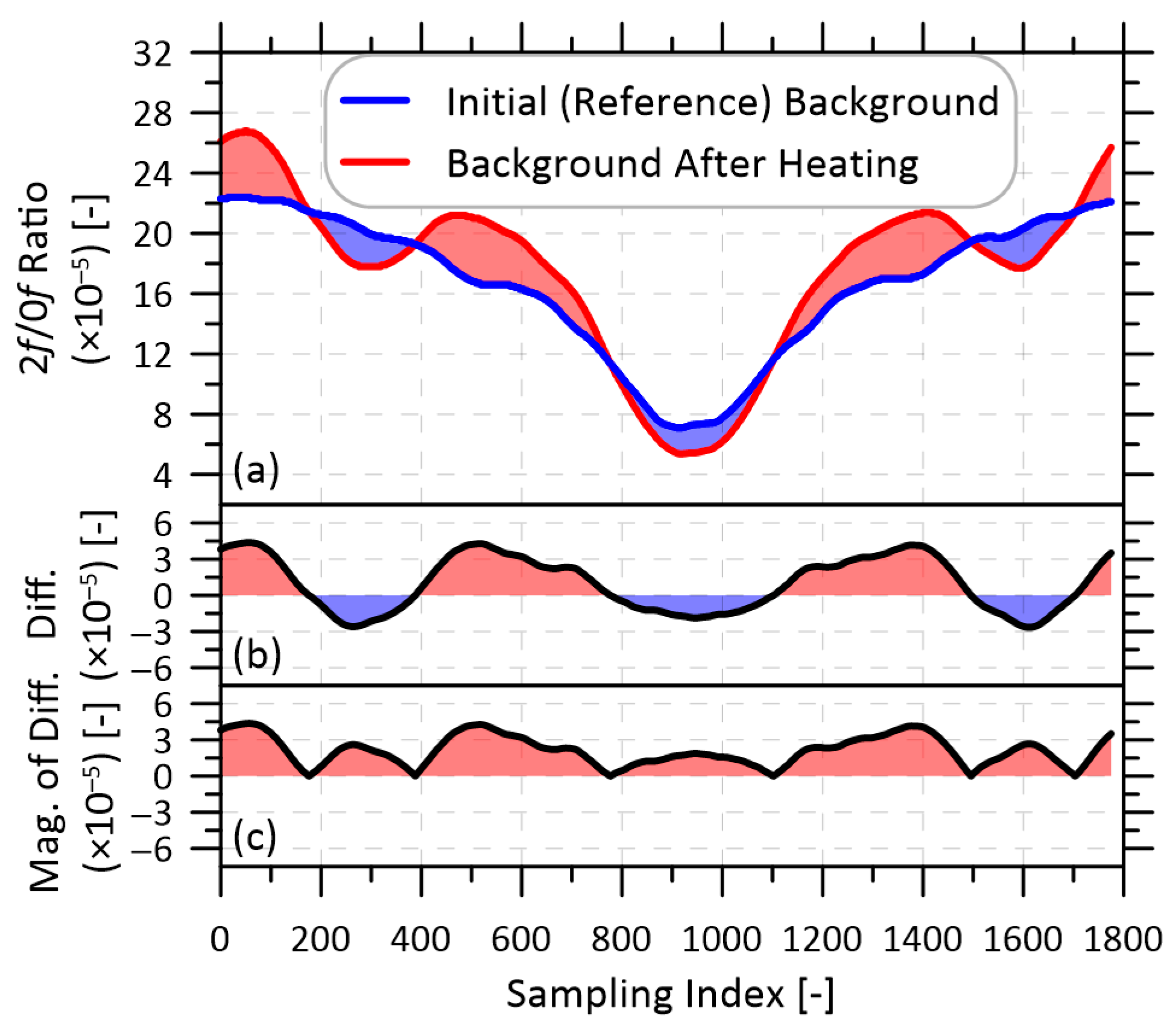
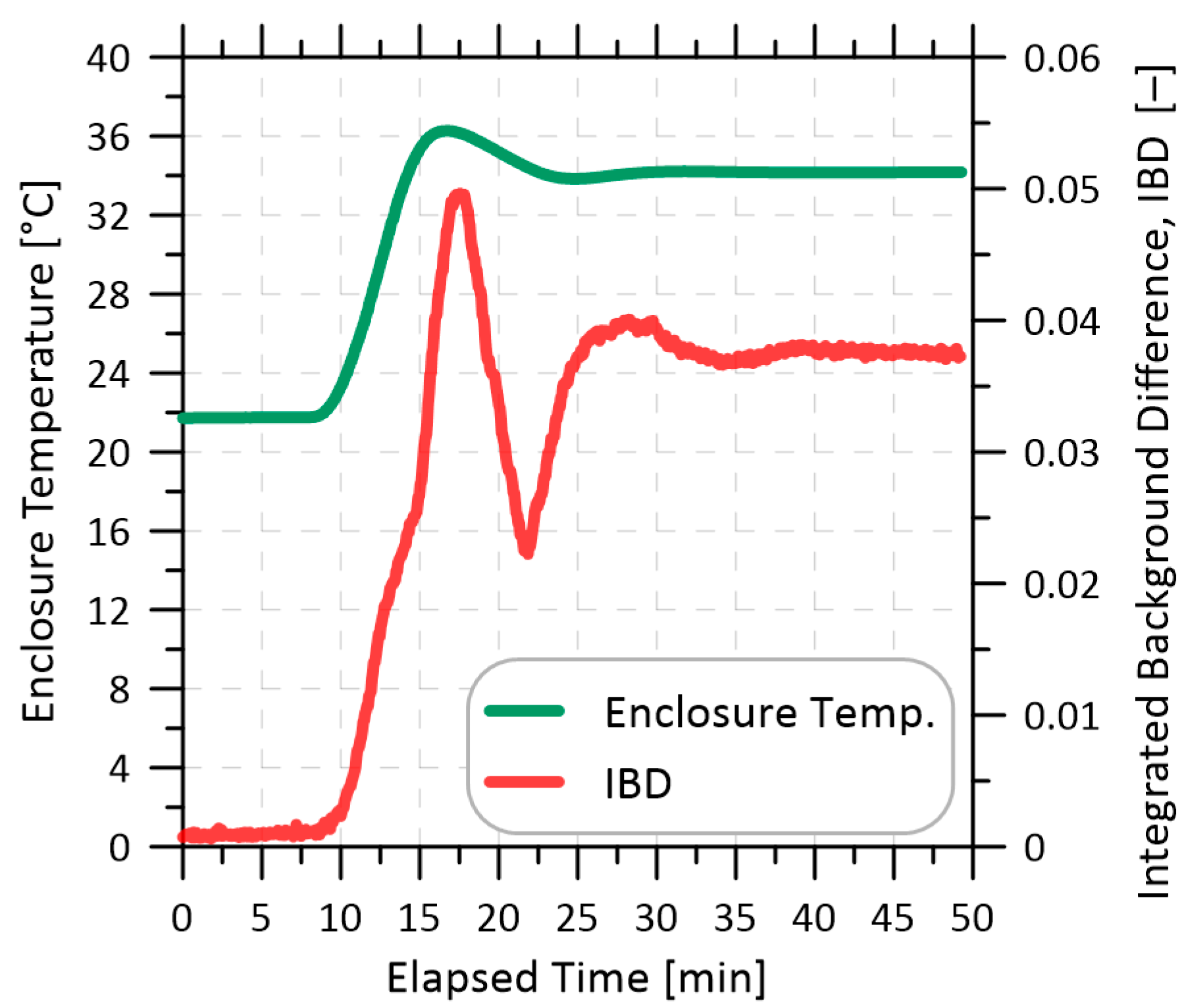

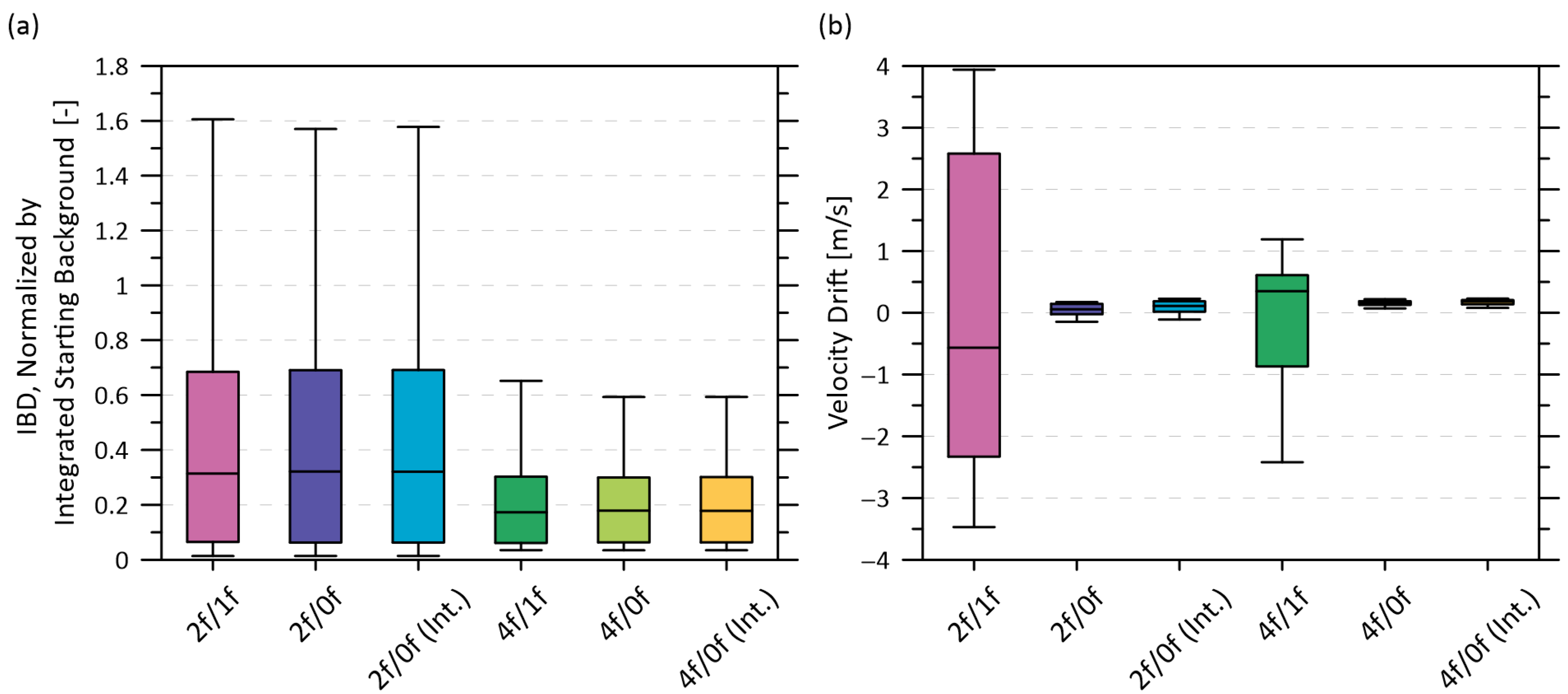

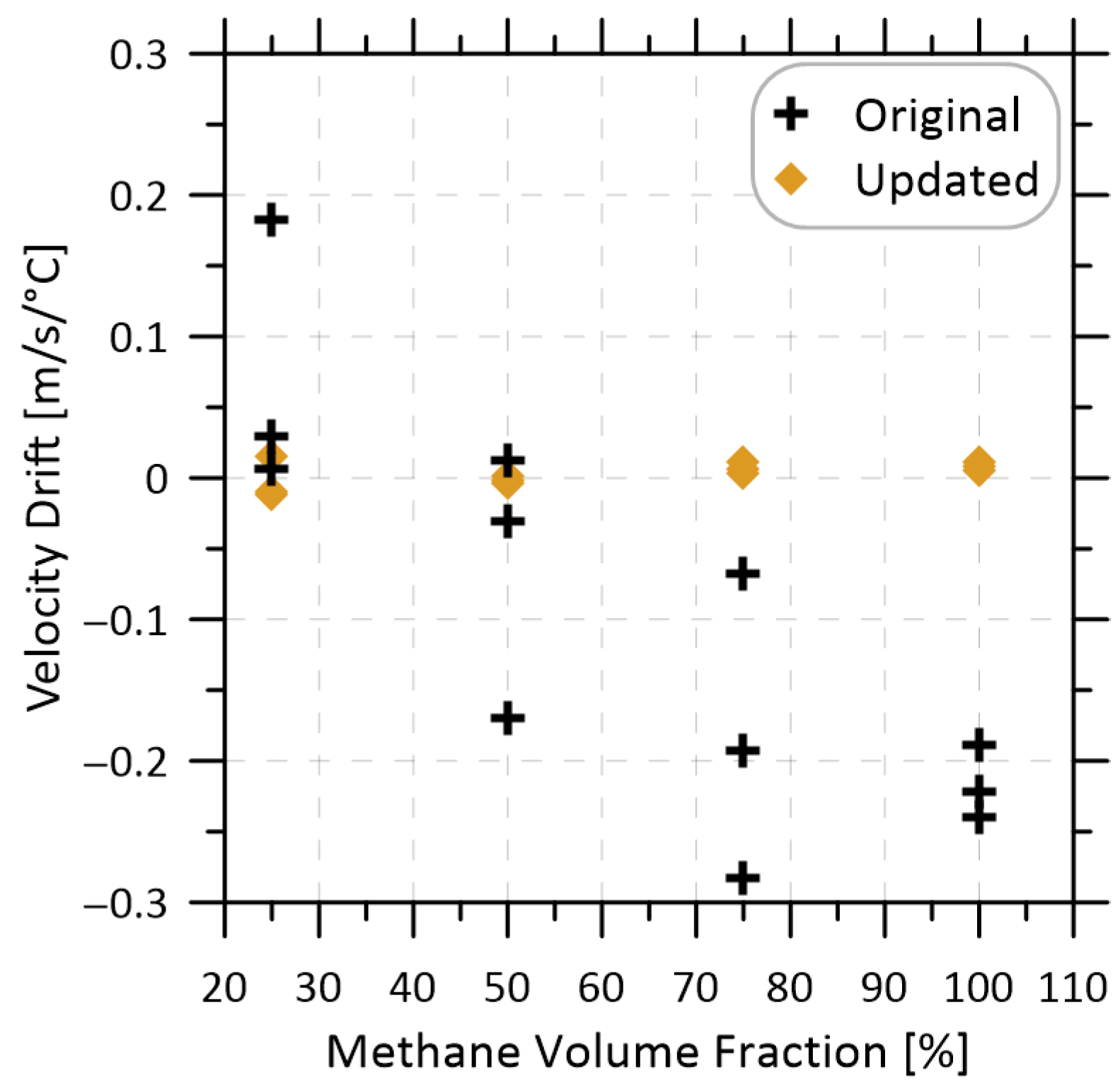
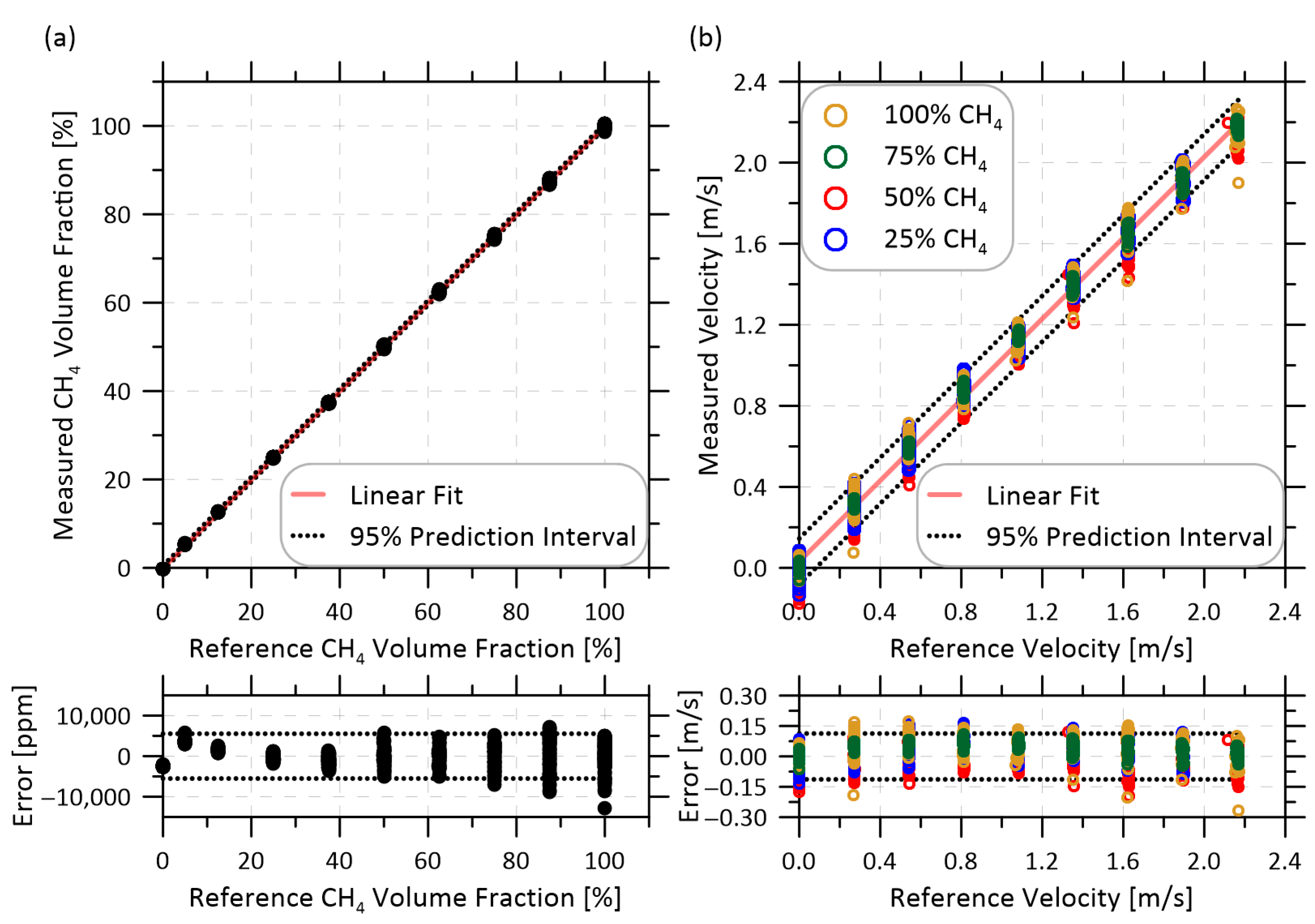
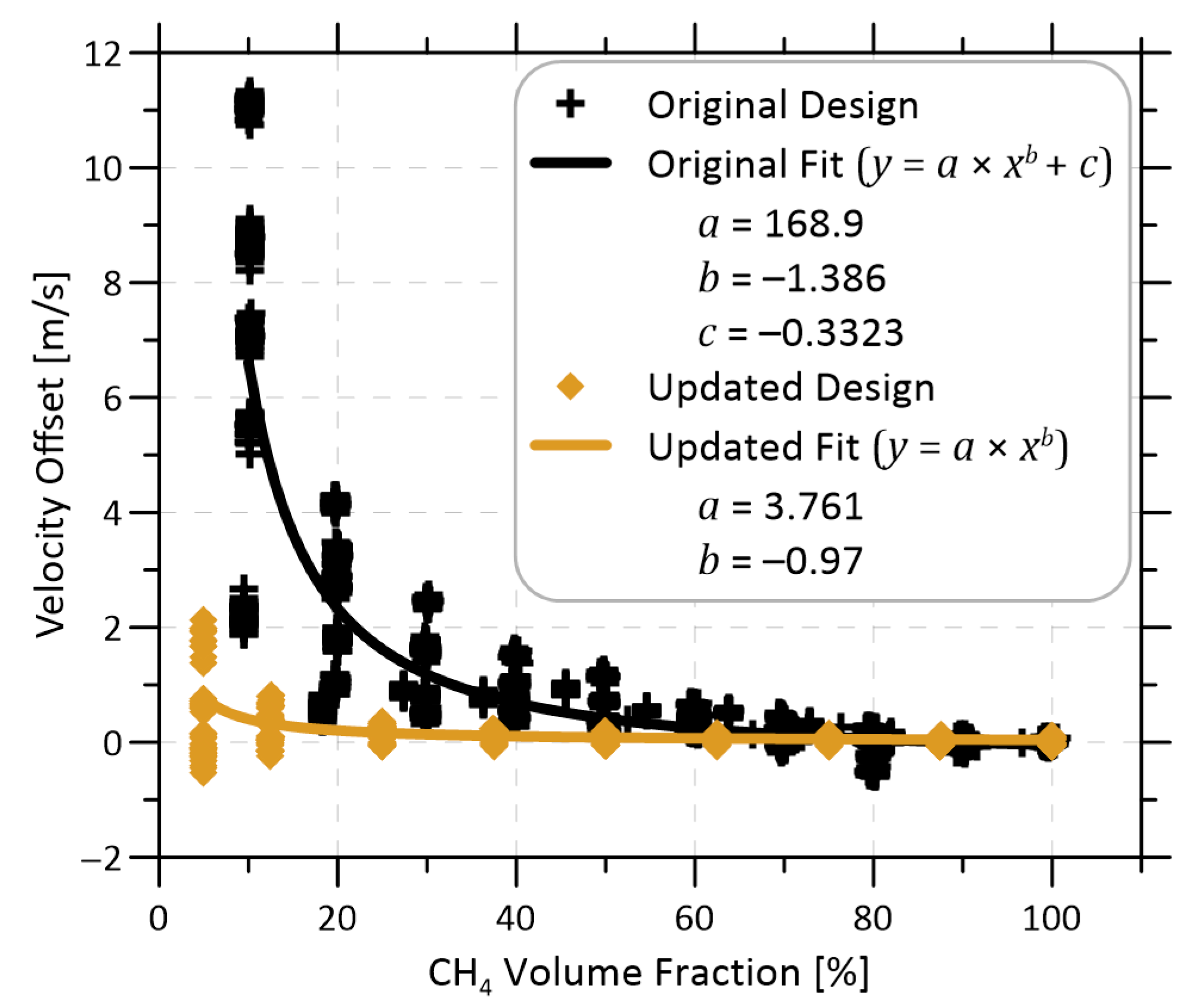
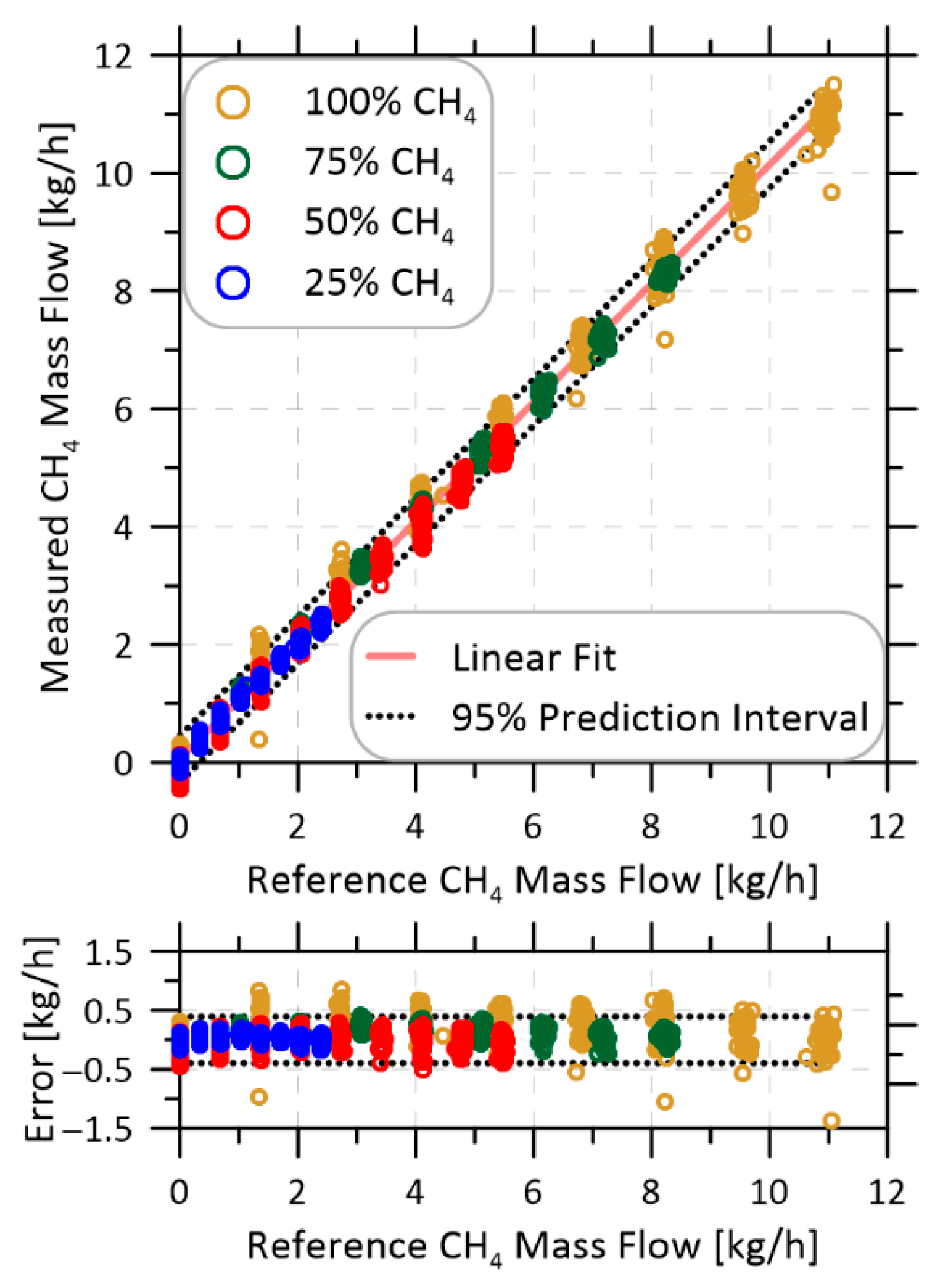
| Component under Test | Test Configuration | Detector | Collimator | Window | Laser, Splitter | Harmonic |
|---|---|---|---|---|---|---|
| Detectors | A | DET1 | COL1 | None | Temp.-stabilized | 2f/0f |
| B | DET2 | COL1 | None | |||
| C | DET3 | COL1 | None | |||
| D | DET4 | COL1 | None | |||
| E | DET5-C | COL1 | None | |||
| F | DET5-UC | COL1 | None | |||
| Launch Collimators | B | DET2 | COL1 | None | ||
| C | DET3 | COL1 | None | |||
| D | DET4 | COL1 | None | |||
| G | DET2 | COL2 | None | |||
| H | DET3 | COL2 | None | |||
| I | DET4 | COL2 | None | |||
| Windows | B | DET2 | COL1 | None | ||
| J | DET2 | COL1 | WW | |||
| Laser/Splitter | K | DET2 | COL1 | None | Temp.-driven | |
| L | DET2 | COL1 | None | Temp.-stabilized |
| Component Type | Component ID | Manufacturer, Model | Description |
|---|---|---|---|
| Detectors | DET1 | Thorlabs, SM05PD4A | 1-mm detector diameter, 800–1700 nm range, InGaAs, unamplified, 0 V reverse bias |
| DET2 | Thorlabs, SM05PD5A | 2-mm detector diameter, 800–1700 nm range, InGaAs, unamplified, 0 V reverse bias | |
| DET3 | Thorlabs, PDA10CS | 1-mm detector diameter, 800–1700 nm range, InGaAs, transimpedance amplified, 5 V reverse bias | |
| DET4 | Thorlabs, PDA20CS | 2-mm detector diameter, 800–1700 nm range, InGaAs, transimpedance amplified, 5 V reverse bias | |
| DET5-C | Laser Components, IG19X1000S4i | 1-mm detector diameter, 800–1870 nm range, extended-InGaAs, transimpedance amplified, 0 V reverse bias, TEC-stabilized | |
| DET5-UC | Laser Components, IG19X1000S4i | 1-mm detector diameter, 800–1870 nm range, extended-InGaAs, transimpedance amplified, 0 V reverse bias, TEC-stabilized disabled | |
| Launch Collimators | COL1 | Thorlabs, RC02APC | Mirrored reflective collimator held in a 2-axis kinematic mount (Thorlabs, POLARIS-K05S1), measured 1/e2 beam diameter ~1.25 mm |
| COL2 | Thorlabs, F110APC-1550 | Singlet lensed collimator with an anti-reflective coating mounted in a threaded 2-axis kinematic mount (Thorlabs, KAD12F), measured 1/e2 beam diameter ~1.29 mm | |
| Windows | WW | Thorlabs, WW10530-C | 3-mm thick N-BK7 window, 30 arcmin wedge angle, and anti-reflective coating (1050 to 1700 nm;). Window was positioned 4 cm from the PD, and angled at 7.4 degrees to minimize back-reflections |
| NW | n/a | No window |
Publisher’s Note: MDPI stays neutral with regard to jurisdictional claims in published maps and institutional affiliations. |
© 2022 by the authors. Licensee MDPI, Basel, Switzerland. This article is an open access article distributed under the terms and conditions of the Creative Commons Attribution (CC BY) license (https://creativecommons.org/licenses/by/4.0/).
Share and Cite
Seymour, S.P.; Festa-Bianchet, S.A.; Tyner, D.R.; Johnson, M.R. Reduction of Signal Drift in a Wavelength Modulation Spectroscopy-Based Methane Flux Sensor. Sensors 2022, 22, 6139. https://doi.org/10.3390/s22166139
Seymour SP, Festa-Bianchet SA, Tyner DR, Johnson MR. Reduction of Signal Drift in a Wavelength Modulation Spectroscopy-Based Methane Flux Sensor. Sensors. 2022; 22(16):6139. https://doi.org/10.3390/s22166139
Chicago/Turabian StyleSeymour, Scott P., Simon A. Festa-Bianchet, David R. Tyner, and Matthew R. Johnson. 2022. "Reduction of Signal Drift in a Wavelength Modulation Spectroscopy-Based Methane Flux Sensor" Sensors 22, no. 16: 6139. https://doi.org/10.3390/s22166139







